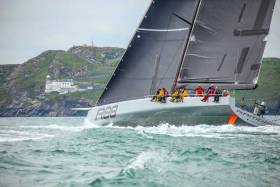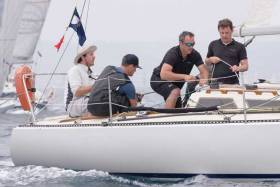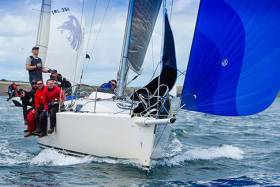Displaying items by tag: Cork Week
Following the recent announcement of the Volvo Cork Week ‘Super Early Bird’ competition winners who won back their full entry fee for the regatta, event organisers have announced a new enticing deal for those who sign up before March 31st. A very lucky 5% of entries received over the next eight weeks will receive a crew gear pack, which contains 10 branded Helly Hansen Crew tops personalised with the boat name, and one skipper’s branded Helly Hansen Regatta jacket, also personalised with the boat name.
With a 45 entries before the end of December, and international interest, indicators show that Volvo Cork Week is shaping up to be the biggest yet with over 50% of total entries for the last regatta already registered, 6 months in advance of the event itself.
With Volvo Cork Week’s new format, and again teaming up with Ireland’s principal sponsor of sailing events Volvo Car Ireland, and local dealership Johnson and Perrott at Mahon Point, the organising committee are focusing on attracting more sailors from more areas of sailing and from a more diverse demographic. This, accompanied by six nights of entertainment, will make for a event in 2018.
Cork Week Super Early Bird Entries Announced
Cork Week has announced the lucky 10% of Super Early Bird entries that will receive a full refund on their entry fee for Volvo Cork Week, which will take place in the Royal Cork Yacht Club from the 16th to the 21st of July next, in association with Volvo at Johnson & Perrott Mahonpoint. Off to a winning start are: Colin Galavan and Richard Hayes with CARPE DIUM, Rory Fekke with F’n Gr8, Anthony O’Neill with Tenacious, Joan Mulloy Racing and Johnny Swan with Harmony.
The event received a whopping 45 entries before the end of December and indicators show that Volvo Cork Week is shaping up to be the biggest and best yet with over 50% of total entries for the last regatta already registered, 6 months in advance of the event itself.
Volvo Cork Week organisers are always looking for new and exciting ways to make the regatta better for competitors. The committee invested a lot of time looking at how best to offer a tailored experience to as many competitors as possible. This year will have a brand new format giving people the option to build their own regatta from the multi series format of the new event. Competitors have the option to enjoy the full five days of world class racing and great entertainment; there is an option of a new, three-day, series for those that can’t commit to the five days; if participants enjoy the longer offshore style racing both fully crewed or shorthanded, then that is also on offer and if participants would like to hold their own class championships, finishing on the Saturday, then that is also an option.
With this new format, and again teaming up with Ireland’s principal sponsor of sailing events Volvo Car Ireland, the organising committee hope to attract more sailors from more areas of sailing and from a more diverse demographic. This, accompanied by six nights of world-class entertainment, will again make for a world-class event in 2018.
Beaufort Cup at Cork Week 2018 Notice of Race - Download here
The Beaufort Cup returns in 2018 and with entry level already surpassing 2016 it is gearing up to be a great success.
Three English teams have already committed to take on the challenge and there’s also interest from Wales, America, France and Northern Ireland.
Download the Notice of Race below
Super Early Bird Entry for Cork Week 2018: Notice of Race Published
The 2018 Notice of Race for Volvo Cork Week, which will take place at the Royal Cork Yacht Club from the 16th to the 21st of July, 2018 has been published (and is downloadable below)
A Super Early Bird entry rate until December 30th where a lucky 10% of entries received before the deadline will get a full refund on their entry fee.
2016 saw a revived interest in the Club’s biennial regatta, which has been going strong since 1978. For its 40 year anniversary in 2018, RCYC is launching an all new format where competitors can pick a choose which element of the week that they wish to attend, giving the options for one, two, or three days racing, or go all in for the full Volvo Cup.
Cork Week organiser Kieran O'Connell told Afloat.ie 'We are also holding a number of One Design Class Championships during the week with racing for these classes on Thursday 19th, Friday 20th and Saturday 21st. If your class would like to be part of this, and benefit from the great entertainment that will be laid on for the week, please get in touch'.
The Beaufort Cup returns in 2018 and with entry level already surpassing 2016 it is gearing up to be a great success. Three English teams have already committed to take on the challenge and there’s also interest from Wales, America, France and Northern Ireland. Download the Beaufort Cup Notice of Race here.
The new Offshore Series on Monday 16th and Tuesday 17th will attract boats from all over to compete in the challenging over night Fastnet race and in the shorter day race Wreck series for the smaller boats.
The online entry system is now live and RCYC is running a Super Early Bird entry until December 30th where a lucky 10% of entries received before the deadline will get a full refund on their entry fee.
2018 – Will This Be Irish Sailing’s 'Year of Years'?
At least two different viewpoints may be taken on the remarkable and very long history of sailing in Ireland. Either you see it as a wonderful heritage, which should be celebrated with gala anniversaries, and whatever you’re having yourself, at every possible opportunity. Or else you might sadly admit that it’s a burden, a deadening load on all of us which stultifies development, restricts fresh thinking, and railroads the annual programme into a traditional pattern sailed in vintage boats which allows very little space for something with the instant appeal and intrinsic excitement of novelty.
But perhaps there’s a happy place somewhere in between, a thoughtful place among many events, where we can live comfortably with some astonishingly old throwbacks to the distant past, yet continue to modify the programme and our way of doing things in order to accommodate new ideas. And with any luck, we might somehow find space to come up with some bright ideas of our own to add to the rich and very varied tapestry of the world sailing scene. W M Nixon casts an eye over next season’s programme to see what it might bring to the party.
After the excitement of Annalise’s Silver Medal in Rio on August 2016, in 2017 there was a generally unstated but definite feeling that we were due a down-home year, a year when sailing in Ireland in all its quirkiness would be celebrated, and anything with a non-Olympic flavour would be given every encouragement to flourish.
Yet at the beginning of 2017, who could have predicted that as summer approached, it would be Annalise herself who would up-sticks from the pre-ordained Olympian way of doing things, and plunge into the maelstrom which is Volvo Ocean Racing?
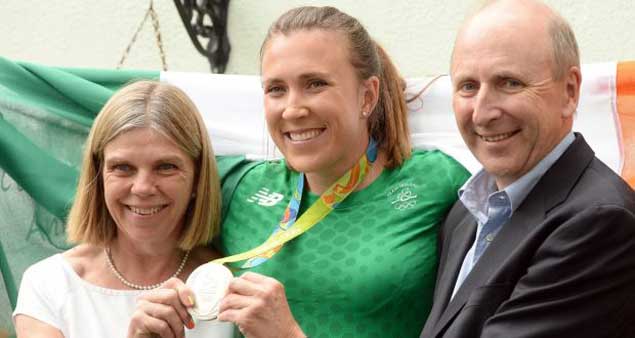 Olympic Medallist Annalise Murphy with her parents Cathy MacAleavey and Con Murphy. As the establishers of a long-standing Round Ireland Record in 1993, Cathy and Con are well aware of what Annalise has faced in taking on a round-the-world crewing job in the Volvo 65 Turn the Tide on Plastic (below)
Olympic Medallist Annalise Murphy with her parents Cathy MacAleavey and Con Murphy. As the establishers of a long-standing Round Ireland Record in 1993, Cathy and Con are well aware of what Annalise has faced in taking on a round-the-world crewing job in the Volvo 65 Turn the Tide on Plastic (below)
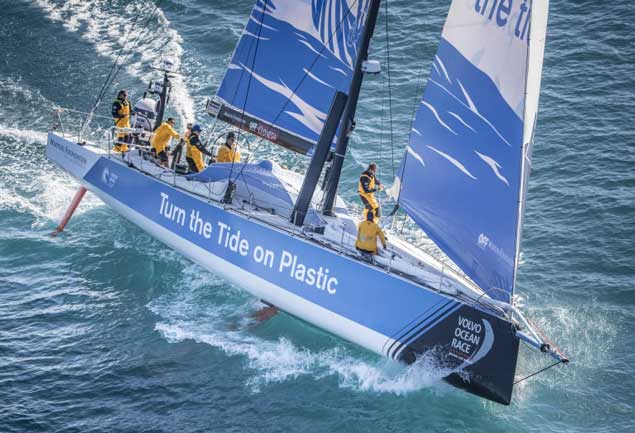
Successful predicting doesn’t get any easier, even with detailed programes taking shape. Annalise’s progress in the rugged ocean racing world this will be continuing until the finish in June 2018, but thanks to the Volvo Race’s flexible approach to crewing arrangements, she will be able to opt out for long enough to get herself back into the Olympic Women’s Radial Laser mode from time to time to keep in touch for the big Tokyo 2020 Olympics countdown event in early August 2018, the two-week Hempel World Sailing Championship at Aarhus in Denmark.
There, with 40% of places up for grabs, many other Irish Olympic wannabees will be progressing after long and often lonely months and even years of doing the circuit. By then, several of them such as Aoife Hopkins will have thoroughly tested the waters in the Olympic Classes, starting with the Championships in Florida in January.
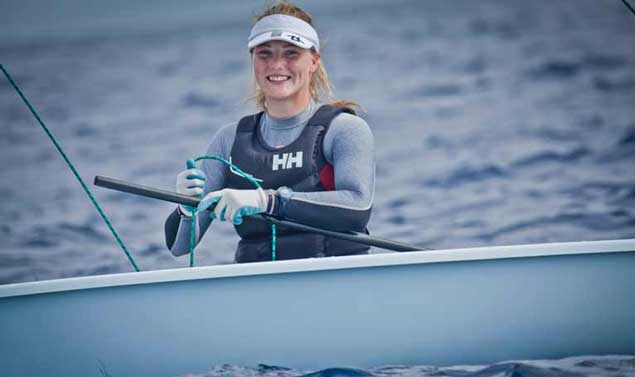 Aoife Hopkins of Howth and Trinity College will be starting her 2018 campaign towards the 2020 Tokyo Olympics in Florida in January
Aoife Hopkins of Howth and Trinity College will be starting her 2018 campaign towards the 2020 Tokyo Olympics in Florida in January
February sees action at home and abroad with the growing enthusiasm for Team Racing in action with the Trinity Varsities up on the lake at Blessington on Friday 9th/Saturday 10th February, which will fit them neatly around the Irish Sailing/Afloat.ie “Sailor of the Year 2017” awards ceremony back down in Dublin at the RDS on the evening of Friday February 9th, where an exceptionally eclectic group of maritime high-flyers will gather to receive well-deserved praise for many remarkable - indeed, in some cases astonishing - achievements.
But late February will also see serious international racing on the other side of the Atlantic with the increasingly popular annual RORC Caribbean 600 starting from Antigua on Monday 19th February. There’ll be a strong Irish contingent, and we have form here, as Adrian Lee’s Cookson 50 Lee Overlay Partners from Dun Laoghaire won the first Caribbean 600 in 2009, then Conor Fogerty’s Sunfast 3600 Bam! from Howth won her class in 2016, and in 2017 it was all back on top again, as the overall winner, Hap Fauth’s Maxi72 Belle Mente, was navigated by our own Ian Moore.
 Bella Mente on her way to winning the RORC Caribbean 600 in February 2017, navigated by Ian Moore. There will be a strong Irish presence in 2018’s race, starting at Antigua on 19th February. Photo Tim Wright
Bella Mente on her way to winning the RORC Caribbean 600 in February 2017, navigated by Ian Moore. There will be a strong Irish presence in 2018’s race, starting at Antigua on 19th February. Photo Tim Wright
However, February at home in Ireland for most sailors is conference time, and the ever-expanding annual Irish sailing Cruising Conference is scheduled for Saturday February 17th at the Clayton Hotel in Leopardstown in Dublin, the move to a Clayton Hotel’s conference facilities having started last year in Cork when bookings were so heavy they’d to change the venue from the original choice of the Port of Cork HQ Building.
Nevertheless those dedicated team racers in school and college are also maximising their use of February before exam countdowns take over everyone’s timetable, and there’s the Leinster Schools at RStGYC on February 17th, while the following weekend is the big one, the Irish Universities Championship. In 2017 they had Clifden as a very successful venue in an early weekend in March, in 2018 they’re pushing the early season envelope even further by using the weekend of 22nd-24th February, and the venue is again in the west, this time at Kilrush, County Clare.
 Springtime sunshine at Clifden in Connemara, March 2017, for the Irish Universities Championship. In 2018, the event will be even earlier – on February 24-25th at Kilrush in County Clare
Springtime sunshine at Clifden in Connemara, March 2017, for the Irish Universities Championship. In 2018, the event will be even earlier – on February 24-25th at Kilrush in County Clare
Thus we reach the end of February with the season already well under way for some specialists, but mainstream sailors will still be in a different time-scale, and in March the first one for the diary is Irish Sailing’s AGM on Saturday 10th March, venue still to be confirmed. However for those who insist that sailing shouldn’t miss any month of the Irish year, the Royal Cork’s famous come-all-ye dinghy festival, the PY1000, is slated in for Sunday March 11th, and it’s quite something, in fact it’s fantastic.
It would be impossible to imagine contemporary Irish sailing without the Laser, that ageless wonder which has contributed so much to our sport since it first appeared here around 1970. Yes, 1970. To be completely accurate, the Laser will be having its Golden Jubilee in 2019, as the prototpypes and first production boats sailed in 1969, so when our first major Laser event of 2018 gets going, the Munsters at Baltimore on March 31st/April 1st, it will be part of a growing celebration which in 2018 will culminate in Ireland in the mega-fleet World Lasers Masters (we’re talking maybe 400 boats) in Dun Laoghaire in a joint NYC/RStGYC venture from 7th to 17th September 2018. That will be a joyous affair to bring Dun Laoghaire Harbour to an upbeat mood as the traditional sailing season draws to its close after a fascinating main programme in the central part of the 2018 summer, with various pillar events the highlights in a continuous and colourful tapestry which takes in every part of the country.
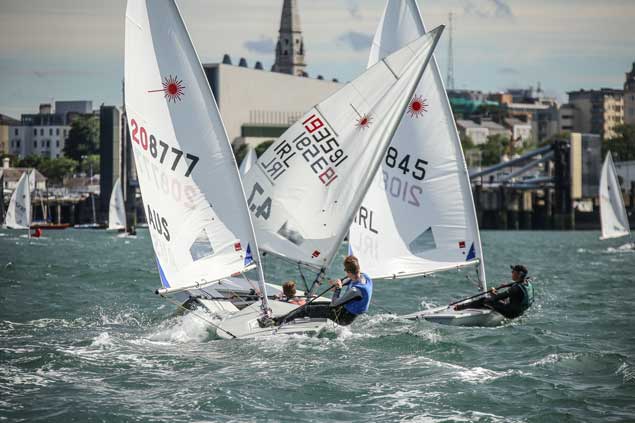 Lasers – it’s part of what we are. This classic dinghy is still as new as tomorrow, yet it’s now on the count-down to the Golden Jubilee in 2019-2020, and a significant part of that will be the World Laser Masters in Dun Laoghaire from 7th to 17th September 2018, with a huge fleet expected.
Lasers – it’s part of what we are. This classic dinghy is still as new as tomorrow, yet it’s now on the count-down to the Golden Jubilee in 2019-2020, and a significant part of that will be the World Laser Masters in Dun Laoghaire from 7th to 17th September 2018, with a huge fleet expected.
That “traditional season” will have seen solid regulars such as the annual programme of the steadily-expanding Irish Sea Offshore Racing Association into action by late April (first races are on April 21st), by which time the Irish Sailing’s Youth Pathway Nationals – 2017 was the biggest yet seen when it was at Ballyholme – will have been staged from 5th to 8th April at a venue yet to be confirmed. And Ireland’s long history of team racing will have been acknowledged yet again, this time with the 70th Anniversary of the senior of them all, the Royal St George series in Dun Laoghaire on April 22nd/23rd. Believe me, over those seventy years, just about everybody in Irish sailing seems to have been a participant in some way or other in this grandaddy of team events.
Into May, and the 12th to 18th sees the Asgard II Tall Ship Reunion Voyage in the Irish Sea on the Tall Ship Pelican, followed by a Gala Ball which will show that although the Asgard II was sadly lost ten years earlier in September 2008 when she sank, her spirit and those who sailed on her lives on, and an Irish tall Ship will sail again.
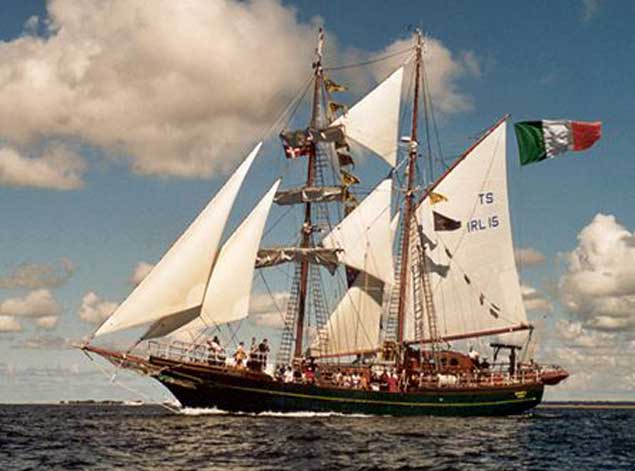 The much-lamented Sail Training Brigantine Asgard II was lost in September 2008, but the tenth anniversary of this sad event will see a renewal of the determination to find an appropriate replacement
The much-lamented Sail Training Brigantine Asgard II was lost in September 2008, but the tenth anniversary of this sad event will see a renewal of the determination to find an appropriate replacement
In May the core pace of mainstream sailing is hotting up, though while you might get sunshine, pure heat is still in short supply in Scotland in the Springtime with snow sometimes still on the mountain-tops for the Scottish Series at Tarbert in late May. But this has long been a happy hunting ground for Irish cruiser-racer crews, and we’ve no doubt the tradition will be maintained.
Meanwhile there’s more chance of a first hint of summer warmth away, far away to the southwest at Baltimore in County Cork where the steadily-growing Baltimore Wooden Boat Festival sees 2018’s staging from 25th to 27th May, and the whisper is there might be some unexpected and interesting visitors making their Baltimore debut.
 The Baltimore Woodenboat Festival in May definitely has something for everyone…
The Baltimore Woodenboat Festival in May definitely has something for everyone…
Back in the Irish Sea, the ingenious Peter Ryan of ISORA managed to devise a race in 2017 which somehow took in Howth YC’s time-honoured Lambay Race as the first part of the course. This will be repeated in 2018, helping to swell numbers in an event which, in the Bank Holiday Weekend of June 1st to 3rd 2018, will be part of Howth’s Regatta, the shoreside high point of which is a family day for the peninsula people which in 2017 was adjudged an outstanding success.
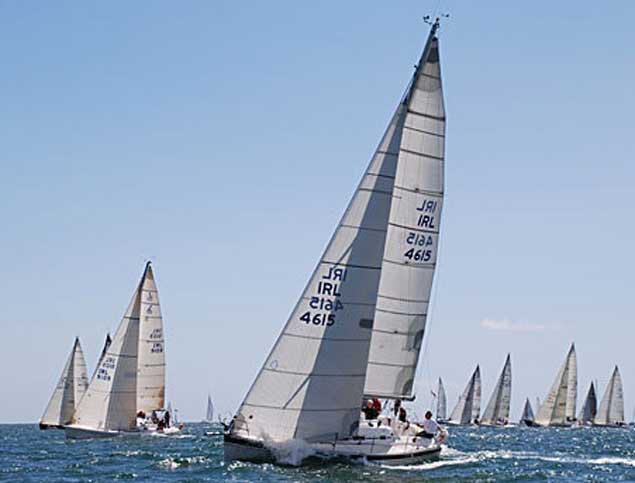 Summer comes to the East Coast - the Lambay Race at Howth, first sailed in 1904. 2018’s will be part of a family-friendly regatta at June’s Bank Holiday weekend, with the Lambay Race itself once again including the successful combination of the first part of an ISORA Race
Summer comes to the East Coast - the Lambay Race at Howth, first sailed in 1904. 2018’s will be part of a family-friendly regatta at June’s Bank Holiday weekend, with the Lambay Race itself once again including the successful combination of the first part of an ISORA Race
Because June’s Volvo Round Ireland Race from Wicklow has been moved from the traditional mid-summer weekend start to the last weekend of the month (presumably to avoid clashing with the finish of the Volvo Ocean Race itself at The Hague in The Netherlands where the stage is set from June 24th onwards), June is quite like old times with each Dun Laoghaire club staging its own Saturday regatta, while at national championship level the J/24s are descending on Foynes from June 8th to 10th, and the Sigma 33s are at the Royal St. George Yacht Club from June 22nd to 24th, while the National 18s in all their fascinating variations get in ahead of everyone with their Nationals at Baltimore on June 2nd/3rd.
Come the end of the month, and all eyes will be focused on Wicklow and the back-up port of Dun Laoghaire for the Volvo Round Ireland Race, counting 1.4 for the RORC points championship, and starting Saturday June 30th. It will be the 20th staging of this very special 704-mile Irish classic (it’s longer than either the Fastnet, the Middle Sea, the Bermuda, the Sydney-Hobart or the RORC Caribbean 600), but the 19th staging in 2016 was such a sensational event, with three MOD 70s and George David’s mighty Rambler 88 stealing the show, that 2018 is going to have to think of something different to make the proper impact.
In the end, its the steady, regular and frequent contenders who are the backbone of this race, and to emphasise this, the organisers are going to find which skipper has had the best accumulated result from the races of 2016, 2018, and 2020. Then at the prize giving after 2020’s race, that top scorer will be awarded a brand-new road-ready Volvo V40.
As to who will be doing the 2018 circuit, we do know already that the winner of the Volvo Dun Laoghaire-Dingle Race 2017, Paul O’Higgins (RIYC) with the JPK 10.80 Rockabill VI, has already signed up the formidable talents of Mark Mansfield of Cork who was on Dave Cullen’s chartered J/109 Euro Car Parks (aka Storm), which was the only Irish boat to win a class in the 2016 circuit.
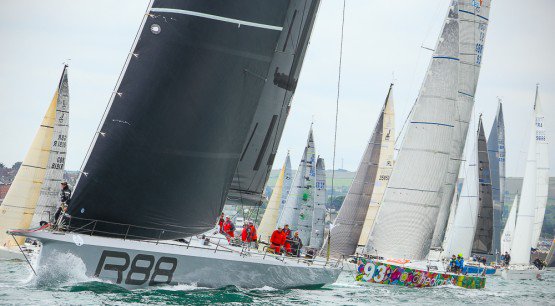 Here she comes….! How on earth George David’s Rambler 88 managed to come cleanly through the crowded start of the Volvo Round Ireland Race 2016 is a matter of wonder, but she did it like a hot and very swift knife through butter. Photo David O’Brien/Afloat.ie
Here she comes….! How on earth George David’s Rambler 88 managed to come cleanly through the crowded start of the Volvo Round Ireland Race 2016 is a matter of wonder, but she did it like a hot and very swift knife through butter. Photo David O’Brien/Afloat.ie
In July the emphasis moves emphatically to the south coast, and you can drive your new Volvo V40 there in expectation of a warm welcome, as the next big one up is Volvo Cork Week from July 16th to 21st. There’ll be an added sense of anticipation to this marvellous biennial sailfest, for it will be the last Cork Week before the big one in 2020, when the Royal Cork Yacht Club Tricentenary Cork Week will be just one of many major events celebrating 300 years of the world’s oldest yacht club.
Who knows, but maybe by 2020 they’ll be staging the Beaufort Cup as a major standalone event. What started as the germ of an idea in February 2016 for a sailing series among crews from the Defence Forces in the Volvo Cork Week of that July took off like a rocket, and 33 public agency crews in 12 mostly borrowed boats, representing just about every organisation and agency which is involved in serving the public, stretching its remit way beyond the defence forces.
Nevertheless it was a Defence Forces crew, skippered by Commandant Barry Byrne racing John Maybury’s J/109 Joker 2, which topped the leaderboard in a series which brilliantly captured genuine public interest. It was an astonishing success, and already entries are registered for 2018 with so much interest that you’d begin to worry whether there’ll be enough suitable boats available for loan to accommodate everyone.
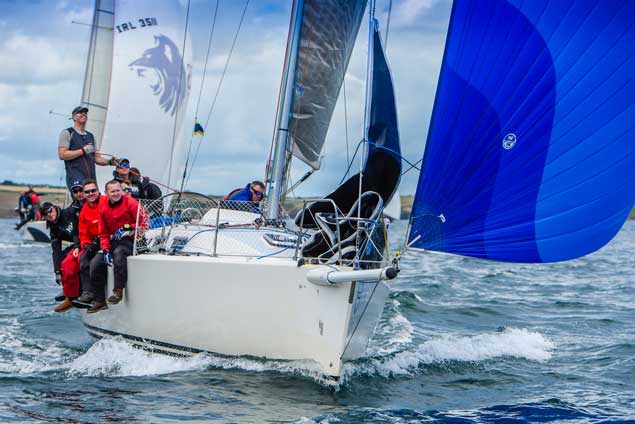 The Defence Forces’ crew, skippered by Commandant Barry Byrne and racing the J/109 Joker 2, were first winners of the Beaufort Cup which will continue as a feature of Volvo Cork Week in 2018. Photo Robert Bateman
The Defence Forces’ crew, skippered by Commandant Barry Byrne and racing the J/109 Joker 2, were first winners of the Beaufort Cup which will continue as a feature of Volvo Cork Week in 2018. Photo Robert Bateman
As it is, taking 12 highly competitive boats out of general competition impinged significantly on the mainstream Volvo Cork Week fleet in 2016, yet having the Beaufort Cup as part of Cork Week is something which adds to the allure of both events, so we sympathise with anyone who, in time, is going to have to square this particular circle. As it is, in 2018 the Beaufort Cup teams are going to be a fully-integrated part of Cork Week, racing the entire five days and savouring the unique Crosshaven Cork Week flavour, but nevertheless there are bound to be those who’ll wonder if extra mileage couldn’t be squeezed from having the Beaufort Cup as a standalone event.
As July veers into August, national sailing interest will swing two ways. Our potential Olympians will be shaping up for the intense contest at Aarhus in Dernmark, and at home in Ireland down in West Cork they’ll be shaping up for the allegedly non-intense Calves Week from Schull. In previewing the 2017 season, we described it as “a fun event with quite serious competitive undertones”, and this was then quoted with approval (and acknowledgement) by the Calves Week Chairman at a subsequent press launch, so if it ain’t broke, why try and fix it, Calves Week 2018 from 7th to 10th August (yes, four days, you’ll do more living in four days in West Cork than you will in a week elsewhere) definitely is a real fun event with quite serious competitive undertones.
 West Cork sailing at its glorious best – Calves Week action in August will be top of the bill in Schull. Photo: Robert Bateman
West Cork sailing at its glorious best – Calves Week action in August will be top of the bill in Schull. Photo: Robert Bateman
Back on the East Coast, meanwhile, the 1898-vintage Howth 17s are putting out the welcome mat on the weekend of August 10th to 12th for a Classics One-Design Regatta. It has been successfully done before with the Mermaids contributing much to the festivities, but this time the Young Gaffers of Howth hope that others – the Glens and Water Wags of Dun Laoghaire spring to mind – might also be interested. Certainly one of the unexpected successes of 2017 was the inclusion of a Classics Division in the Volvo Dun Laoghaire Regatta as part of the Bicentenary Celebrations for Dun Laoghaire Harbour, an idea which proved so popular there’s talk of doing it again in 2019, but it’s quite a challenge – getting venerable wooden boats and their characterful crews together is about as easy as herding cats.
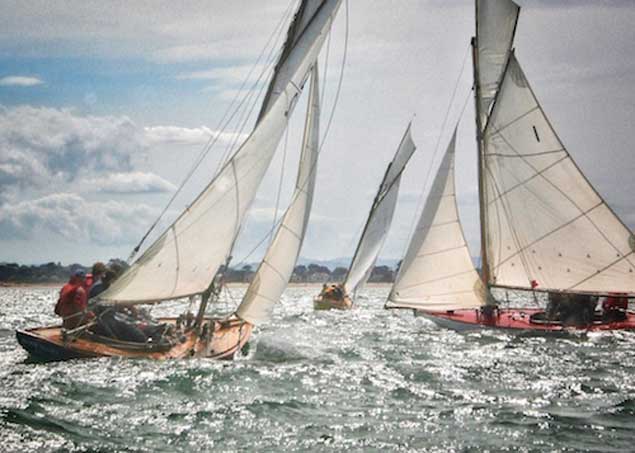 The 1898-vintage Howth 17s will be welcoming other classic One Designs to their home port on August 10th to 12th.
The 1898-vintage Howth 17s will be welcoming other classic One Designs to their home port on August 10th to 12th.
Normally August in a non-Fastnet year is a laid-back time for cruiser-racers when it’s possible to slip in one or two well-supported distance races in the Irish Sea, but August 2018 is going to be unprecedented, as both the WIORA Championship and the ICRA Nationals are going to be staged at Galway City from the 15th to the 18th of August.
Traditionalists will be ruffled by it being in August rather than June, and in the heart of the West Coast rather than at either end the old time-honoured basically Cork-Dublin axis. But ICRA Commodore Simon McGibney of Foynes and his team know that there is a strong core ownership of cruiser-racers along the length of the western seaboard (think of the 44 boats which turned out for the WIORA Championship in the Aran Islands at exactly the same time as the massive Volvo Dun Laoghaire Regatta 2017 was under way) and this fresh-look cruiser-racer gathering in Galway deserves every chance of success.
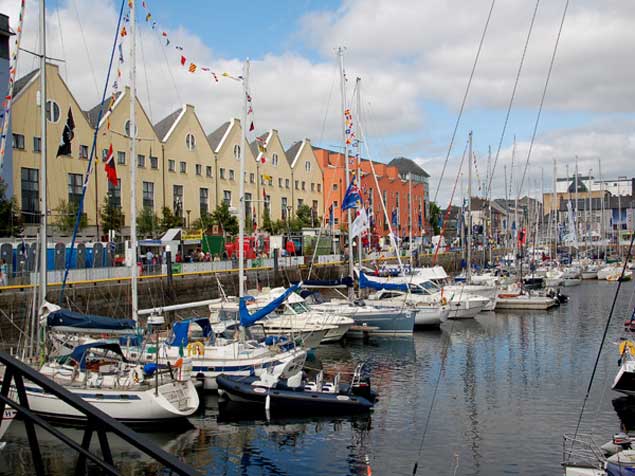 Regatta base in the hart of a hospitable city – Galway will be the hosting port for the WIORA Championship/ICRA Nationals 2018 from August 15th to 18th
Regatta base in the hart of a hospitable city – Galway will be the hosting port for the WIORA Championship/ICRA Nationals 2018 from August 15th to 18th
This preview of the cornucopia of events which 2018 has to offer is no more than a skimming of the peaks, with occasional in-depth glances at some curious corners of special interest. The sheer diversity of events, boats, locations and people involved is outlined in the detailed Irish Sailing schedule, and every sailor will find his or her favourite event there. But inevitably that detailed schedule is still far from complete. After all, in previewing 2016, even in January of that year we would not have been able to anticipate the huge success of the Beaufort Cup in July, for the then Minister for Defence Simon Coveney TD and his team didn’t have the inspired idea of the Beaufort Cup until late February.
 The SB20 Europeans promises some lively action on Dublin from August 28th – September 1st, at the Royal Irish Yacht Club hosted event Photo: David O'Brien/Afloat.ie
The SB20 Europeans promises some lively action on Dublin from August 28th – September 1st, at the Royal Irish Yacht Club hosted event Photo: David O'Brien/Afloat.ie
Nevertheless some things have been part of our sailing lives for decades, and every year September brings an entirely new mood, with established summer programmes drawing to a close, Autumn Leagues getting themselves into gear, and All-Ireland Championships to be raced.
The Juniors will be in the last weekend of September, venue and boat type still to be confirmed, but the Seniors are firmly in place at Lough Ree Yacht Club on the weekend of 13th to 14th October, to be raced in SB 20s.
There’s something very pleasing about the fact that the core stream of Irish sailing at home should reach its time-honoured concluding Championship of Champions in the heart of the country at a hospitable club which can trace its history back to 1770, with the event itself being raced in boats of a modern international class which has special Irish links. 2018 Irish sailing at home does indeed give every sign of being another memorable year, with a stylish and upbeat concluding championship.
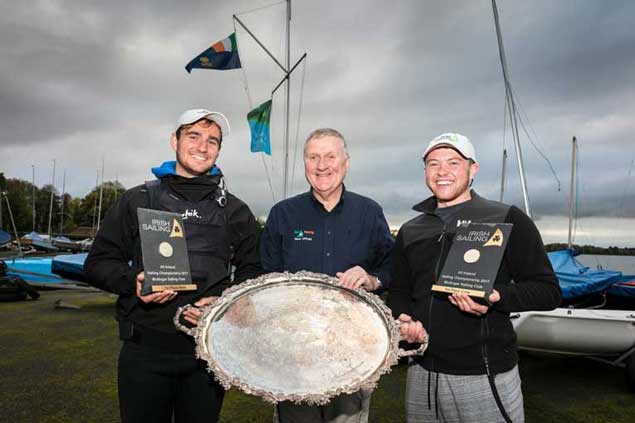 Fionn Lyden of Baltimore Sailing Club (left), with Irish Sailing President Jack Roy and crewman Liam Manning of Schull, and the historic All-Ireland silver salver he won on Lough Owel at Mullingar in October 2017. He will be defending at the All Irelands at Lough Ree on October 13th-14th 2018. Photo Irish Sailing
Fionn Lyden of Baltimore Sailing Club (left), with Irish Sailing President Jack Roy and crewman Liam Manning of Schull, and the historic All-Ireland silver salver he won on Lough Owel at Mullingar in October 2017. He will be defending at the All Irelands at Lough Ree on October 13th-14th 2018. Photo Irish Sailing
2018 SAILING HIGHLIGHTS
January Florida USA (Ft Lauderdale & Miami) – Olympic Classes Regattas
February 19th Antigua – RORC 600
March 12th Royal Cork YC - PY 1000
April 5th – 8th Irish Youth Pathway Nationals
April 21st ISORA season starts
May 25th – 29th Scottish Series, Tarbert
June 1-3rd Howth Regatta & Lambay Races
June 30th Volvo Round Ireland Race
July 16th-21st Volvo Cork Week with Beaufort Cup
July 30th – August 12th Hempel World Sailing Championship Aarhus, Denmark
August 7th-10th Calves Week, Schull
August 15th – 18th WIORA Championship & ICRA Nationals, Galway
August 28th – September 1st, SB20 Europeans, Royal Irish Yacht Club
September 7th – 15th September Laser Masters World Championships, RStGYC & NYC
September 29th-30th All Ireland Junior Championship (venue to be confirmed)
October 13th – 14th All Ireland Senior Championship, Lough Ree YC, sailed in SB20s
'Cruiser Racing is on the Way Back'– Royal Cork's Kieran O'Connell
Interest in keelboat racing is increasing. Cruiser racing is on the way back! So says the Royal Cork Yacht Club’s Rear Admiral for Keelboats, Kieran O’Connell, writes Tom MacSweeney.
Clubs around the coast have experienced a fall-off in racing numbers at cruiser events over the past few years. ‘Keelboats,’ a traditional Class description, have changed fundamentally in design as cruiser/racers have evolved since they were first labelled as ‘keelboat racing’.
“There was a decline, numbers have been down, but this season there has been an improvement and an upsurge in interest,” O’Connell told the prizewinning club racers (See Afloat's Gallery here) at the annual presentation of prizes when he pointed to the turn-out for the Autumn series/October League and what has been a surprisingly big entry for the November/December Winter League which is still underway at the club, in which an average 30 yachts are on the water.
 Cruiser racing on the up – Cork Harbour has seen strong turnouts for its Winter sailing season. Photo: Bob Bateman
Cruiser racing on the up – Cork Harbour has seen strong turnouts for its Winter sailing season. Photo: Bob Bateman
“This is encouraging and indicates that interest and participation in cruiser racing is on the up. It has turned around after a few difficult years.”
Kieran O’Connell is also Commodore of the South Coast Offshore Racing Association (SCORA) which combines Southern clubs planning events for the annual sailing calendar.
To general applause, he told the RCYC cruiser racers that he intended to stay in office to steer ‘keelboat’ racing for a while yet. That is good news for the cruiser racing, as he has put a lot of work into orchestrating its revival.
More in the weekly Sailing Column in the Cork Evening Echo.
With nine confirmed entries already for the 2018 edition of the Beaufort Cup, Cork Week Chairman Kieran O'Connell of Royal Cork Yacht Club says it promises to be a great event. '2016 was the inaugural event and we saw 12 different services compete for the title. We are set to have a significant increase on that number in 2018,' O'Connell told Afloat.ie
The Beaufort Cup invites sailing teams from associated national services, 50% of each team must be active in the service they represent.
Racing will take place over five days in a mix of offshore and inshore racing.
Teams will get the chance to enjoy the 'renowned social experience' of Volvo Cork Week and the winning team will also have €10,000 donated to a nominated charity of their choice while the winner will also be eligible for the Volvo Cork Week Cup (Boat of the Week across the full 5 days) at Cork Week 2018.
Download the Notice of Race below.
New Dates for Cork Week 2018 To Avoid Round Ireland Race Clash
Only a week after the launch of a revamped Volvo Cork Week, Royal Cork Yacht Club has been forced to change the date of next year's regatta by a week to July 16th – 21st.
'We have encountered a problem and have decided to change the date of VCW18', Cork Week Chairman Kieran O'Connell admitted.
The Round Ireland Race (June 30th) and the Round The Island Race (July 7th) are already important fixtures in 2018 sailing calendars and as a result, we've taken the decision to move the dates to July 16th – 21st', O'Connell told Afloat.ie
Just a week ago, as Afloat.ie reported here, RCYC issued details of a brand–new format for the regatta offering cruiser–racers the option to choose from the multi–series format of the new event.
The new event will feature 12 competitive classes in IRC and ECHO handicaps. There is racing for the Volvo Cork Week Cup, Club Regatta Day, Inshore Races, the Beaufort Cup, plus a new 'Offshore and Wrecks' series.
'We've been caught 'OCS' and are taking on board the feedback', O'Connell said.
A full Notice of Race will be issued in the coming weeks, according to O'Connell.
'Build Your Own Cork Week', Royal Cork Yacht Club Unveil New Format for 2018 Regatta
Royal Cork Yacht Club has shaken up the format of its 2018 Volvo Cork Week Regatta following an exit survey of competitors at the 2016 event.
A brand-new format for the regatta that runs from 9th – 14th July 2018 offers cruiser–racers the option to choose from the multi–series format of the new event.
The new event will feature 12 competitive classes in IRC and ECHO handicaps. There is racing for the Volvo Cork Week Cup, Club Regatta Day, Inshore Races, the Beaufort Cup, plus a new 'Offshore and Wrecks' series.
 Dublin Bay JPK10.80 Rockabill competing in 2016's Cork Week Harbour Race Photo: Bob Bateman
Dublin Bay JPK10.80 Rockabill competing in 2016's Cork Week Harbour Race Photo: Bob Bateman
'We are always looking for new and exciting ways to make the regatta better for you the competitor. This year is no different, RCYC's Kieran O'Connell, the Cork Week Chairman, told Afloat.ie
'On receiving the results of the survey carried out after the regatta in 2016, one thing became very clear to us. Every individual competitor’s needs and wants are very different', O'Connell explained.
Using the survey as a guide, the Volvo Cork Week committee spent a lot of time looking at how best to offer a tailored experience to as many competitors as possible. We have always said that Volvo Cork Week is a regatta run by sailors for sailors, so we decided adhere to this mantra and create a regatta built by sailors.
O'Connell says some of the possibilities at the 2018 regatta are:
· If you as the competitor enjoy coming to Cork Week for 5 days of world class racing and great entertainment then that is on offer.
· If you as competitor enjoy coming to Cork Week but find it hard to get five days off, then we have a three-day series and that is on offer.
· If you enjoy just doing the longer offshore style racing both fully crewed or shorthanded, then that is also on offer.
· If you would like to hold your class championships finishing on the Saturday then, you said it, that is on offer too.
Download the advance notice of race below
All Afloat.ie's Cork Week coverage in one handy link here
ICRA Debate: Can Cruiser National Championships Afford To Be Stand Alone Event in Crowded Sailing Calendar?
The Irish Cruiser Racer Association must be applauded for providing a platform under the theme: 'we need to talk about cruiser racing' at tomorrow's conference in Limerick. Like an elephant in–the–room, the overcrowded Summer fixtures needs to be urgently addressed because it's not only the hosting clubs and competitors that suffer but the sport itself.
Between June 9 and July 9 Irish cruiser–racers have – in date order – the ICRA Nationals in Royal Cork YC (June 9–11), Sovereigns Cup at Kinsale Yacht Club, (June 21-24) Dun Laoghaire Regatta on Dublin Bay from (July 6-9) and Galway's WIORA on the Aran Islands from July 5–8.
On top of this, the biennial Dun Laoghaire to Dingle offshore race sets sail from the National Yacht Club for a three–day race on June 14.
These major events are icons of Summer sailing but how much do we lose by having them all within one month?
With a total available racing fleet of say up to 150 keelboats in Ireland, very few boats will do all five events, not least because WIORA and Dun Laoghaire regatta dates clash.
For many skippers, getting enough crew to do even two of these events will be an achievement in itself.
And, in what is becoming a well identified problem at club level, the successive nature of these events will certainly have a knock–on effect in crew availability for local racing.
Already Dublin Bay Sailing Club has taken a pragmatic approach and scrubbed its own long standing DBSC Cruiser Challenge because of this congestion.
It may seem blindingly obvious but it needs to be said, the Irish keelboat sailing calendar has just too many events for the times that are in it.
Does such congestion best showcase our sport? Attract sponsors or discourage them? And most importantly does it suit the sailors?
It's not the first time Water Rat has mentioned it. He raised it back in 2013 when one senior organiser saw fit to deny the situation and gave poor Water Rat a good talking to into the bargain. Unfortunately, the officer subsequently added that his muscular comments were off–the–record.
Four years later, nothing it appears, has changed except that new ICRA commodore Simon McGibney has invited all to the Limerick gabfest to talk about the future of cruiser racing.
Everyone supports the notion of the ICRA National Championships because it is an extremely worthy event that has, since its inception, done so much to raise the profile of cruiser-racing, an aspect of the sport hitherto poorly represented.
But in the current environment could this event not be included within a Sovereigns Week/Dun Laoghaire Week/Cork Week scenario thus reducing:
- crew demands
- volunteer fatigue within clubs,
- resources and logistics
- costs
At the same time, such a rejig would give a much needed boost to the regatta that would now include a 'National Championships'.
ICRA National Championship Must Keep its Own Identity
Equally, in such a set–up, it is essential the ICRA championship keeps its own identity. After all, it is a national championships, and that's the formula that proves popular with competitors, so it is vital it is not subsumed by any regatta.
ICRA could consider four year cycles. All the events to run from, say, a Wednesday to Saturday to maximise club takings. If it started next year then it could go to Cork Week, Dun Laoghaire in 2019, Howth 2020, Sovereign's in 2021 or some other rotation of this. A review could take place in year three of four to see if other venues wanted a piece of the action. Belfast, anyone? Existing venues also might want to drop out or change dates to fit the recast schedule.
This would not mean the ICRA Nationals concept falls away. On the contrary, ICRA instead works with the existing regatta committees to deliver it's goal of providing quality racing for IRC and ECHO boats and to enable the growth of the sport and to maximise the numbers of people afloat. This all happens. ICRA are merely using existing regattas as their vehicle to deliver. ICRA becomes more overseer than organiser and the regattas benefit from the additional UK exposure that ICRA manages to attract.
ICRA should be applauded for bringing everyone together to discuss this subject. Lets see what overhaul comes out of round table discussions at Castletroy.
Water Rat
































